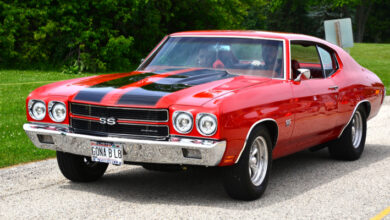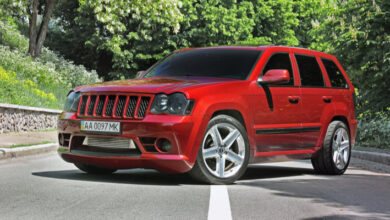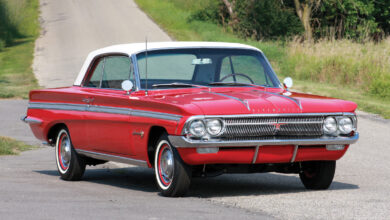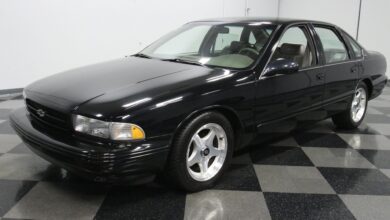More Pickup Utility Coupe Madness with the Ford Ranchero
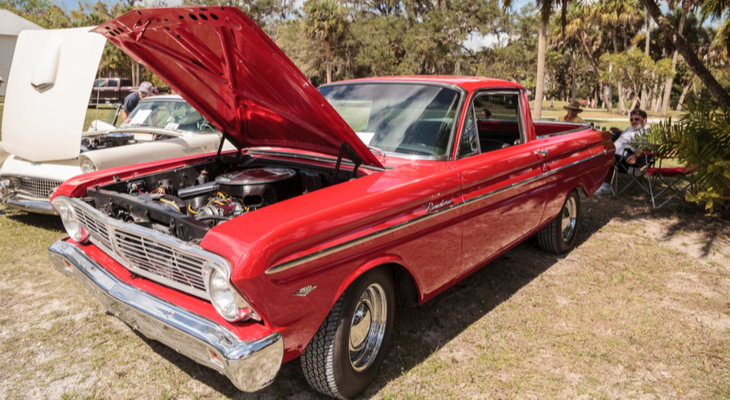
When it comes to practical utilization without sacrificing mobility, manufacturing a 2-door coupe with a functional truck bed makes sense. Cue the Ford Ranchero, both a cult classic and a fine example of innovative automotive history.
Even though assembly occurred on the automobile side, Ford sold the Ranchero under their truck division. At times, the Ford Ranchero may have experienced a case of mistaken identity. Short of finding a home on the Island for Misfit Toys, the Ford Ranchero is a bit of a car and a truck.
The pickup utility coupe market exploded in the late 50s, thanks to the Ford Ranchero. Ford produced the Ranchero from 1957 to 1979, but the path of this 2-door pickup coupe’s existence began decades earlier.
In the early 1900s, many custom modified pickup truck versions of the Ford Model T and Model A hit the roads. By placing a pickup box behind the body of a car or roadster, the first custom utility vehicles arrived on the scene.
From there, the design evolved in the hands of an Australian, Lew Bandt, by creating a coupe featuring a cargo bed. This “ute”, assumingly slang for utility, body style is still popular in Australia today. However, its popularity eventually dwindled down under in the United States.
Upon its release, Ford’s Ranchero proved so successful, Chevy responded by producing the El Camino. Although they are often considered rivals, the Ranchero and El Camino only competed directly for the 1959 model year.
Ford Ranchero Production Years by Generation:
- First Generation – 1957-1959
- Second Generation – 1960-1965
- Third Generation – 1966-1967
- Fourth Generation – 1968-1969
- Fifth Generation – 1970-1971
- Sixth Generation – 1972-1976
- Seventh Generation – 1977-1979
The Fashionable First Generation Ford Ranchero
Many collectors prefer first generation Ford Ranchero models for its extravagant 50s styling. First generation Rancheros feature vintage American retro design with a stroke of flair. When it comes to experiencing back-to-the-50s nostalgia, the first-gen Ranchero nails it.
Ford offered two versions of the first-gen Ranchero, a base model and an upscale version. Base model Rancheros provided utility solutions targeted at truck consumers. Upscale Ranchero editions feature many of the premium options available with luxurious models such as the Ford Fairlane.
Second Generation Ranchero Shifts Gears
Second generation models are also known as the Ford Falcon Ranchero. Other than having a slightly different name, second-gen Rancheros feature a modernized 60s facelift from a design perspective. It is also smaller in comparison to the first generation models.
At the time, Ford’s research concluded the market demanded a smaller, lighter and more affordable pickup truck option. All second generation Ford Rancheros featured a Thriftpower inline-6 or Windsor V8 engine from the factory.
Third Generation Ford Ranchero
For Ford’s third generation of the Ranchero, the instantly recognizable dual vertical headlights are iconic. Unfortunately, Ford only produced this version for one model year, in 1967. Ford also kicked Falcon off the Ranchero for its third generation offspring.
Perhaps the Ford Ranchero’s coming of age occurred with the more powerful third generation. Up to a 390 cubic inch, 6.4L V8 engine was available from the factory. When combined with the optional 4-speed manual transmission, driving this V8 is like handing junior the keys with a fresh license.
Additional 3-speed manual or automatic options provided consumers with transmission choices throughout the third generation’s production. Of course, production only lasted for two model years. Although not impossible to find, there are not as many of these available as other generations.
Fourth Generation Ranchero: Growth Potential
Updated styling with an increased overall size highlight the noticeable exterior changes for the fourth generation. Look for the dual horizontal round headlights on both sides of the grille as an identifying marker.
Ford offered three trim levels of the fourth-gen Ranchero. The base model, the Ranchero 500, and their best offering, the Ranchero GT. Though they are rare, in 1969, a Rio Grande edition became available as a special order option.
There were six different engines used throughout the fourth generation of the Ranchero. In the middle of 1968, the 7.0 liter Cobra Jet engine entered the picture. This was the most powerful engine ever featured in the Ranchero from the factory.
Fifth Gen Grains
Ford completely restyled the Ranchero for its fifth generation model. The front end now featured a sharply tapered grille with an era-identifying centerpoint convergence line on the hood. A “shaker” hood scoop also became available.
The fifth generation of the Ranchero introduced a fourth trim option in 1970. Now, available as a higher-end trim package, the Ranchero Squire provided a touch of class to the Ute segment. This featured a wood-grain exterior design, similar to the Country Squire station wagon.
1970 also was the first year that Ford included any interior badges featuring the name Ranchero on them. An optional grille gave owners the chance to have hide-away headlamps while adding some style. The 1971 model year Ranchero features a grille with a divided center section to cap off the fifth generation.
Sixth Generation Restyling
Ford redesigned the Ranchero yet again in 1972. The pointy edges disappear and an oval-like grille forms the new face of the front end. Sixth-gen Rancheros were available in a base 500 model, the redesigned Squire, or a peppy GT model.
The Desirable Seventh Generation
Many enthusiasts of Ford’s classic LTD II have a soft spot for the seventh generation Ranchero due to the similar front end design. However, Ford only produced seventh generation Rancheros from 1977 to 1979.
All seventh-gen Ranchero models feature a Ford V8 engine from the factory. This body style is a very popular choice among collectors and custom Ranchero builders.
Finding Your Ranchero
Kicking the tires on a Ford Ranchero is affordable. Some of the most pristine original examples or the wildest custom modified Rancheros fetch more than $30,000. However, clean examples across a wide range of Ranchero production years are available for under $10,000.
Some collect for nostalgia, others for appreciation of the classics. Of course, some want the best performing collectible editions available. Plenty of high-performance Ford Ranchero models exist, including some with the legendary Cobra Jet engine from the factory.
Some High Performance Ford Ranchero Factory-Installed Engines:
- 1967-1969 – 390 Cubic Inch 6.4L V8
- 1968-1973 – 428/429 Cubic Inch 7.0L Cobra Jet V8
- 1972-1979 – 400 Cubic Inch 6.6L V8
- 1974-1976 – 460 Cubic Inch 7.5L V8
For the right price, it is possible to enjoy a powerful Ford Ranchero while benefiting from its useful practicality. There are also several non-factory custom engines available within the Ford Ranchero market. They may be worth taking a look at if an all-original, high performance Ranchero proves tough to find.
Predicting the future valuation of cars is tricky business, but recent rumors of a re-release could influence the Ranchero market. With such a strong shift in the market toward smaller SUVs, could there be room for a modern subcompact truck?
Until that day, the best way to enjoy the Ute life may be in a vintage Ford Ranchero. Who knows what values will do, but if Ford officially unveils a new Ranchero, vintage models may see an increase in demand. No matter what, the Ford Ranchero legacy will always live on through the classics.
With over 500,000 Ford Rancheros built during its production lifecycle, plenty of them are available to carry the torch. From building one your way to preserving an all-original Ranchero, you will find one if you want one. Sometimes economical nostalgia pays higher dividends when looking at the big picture.
The Ford Ranchero provides you with a classic American automobile experience without any guilt on a Sunday drive. Whether driving to church or taking pigs to the market, the Ford Ranchero always gets the job done. Making life more convenient is what the Ford Ranchero is born to do.
